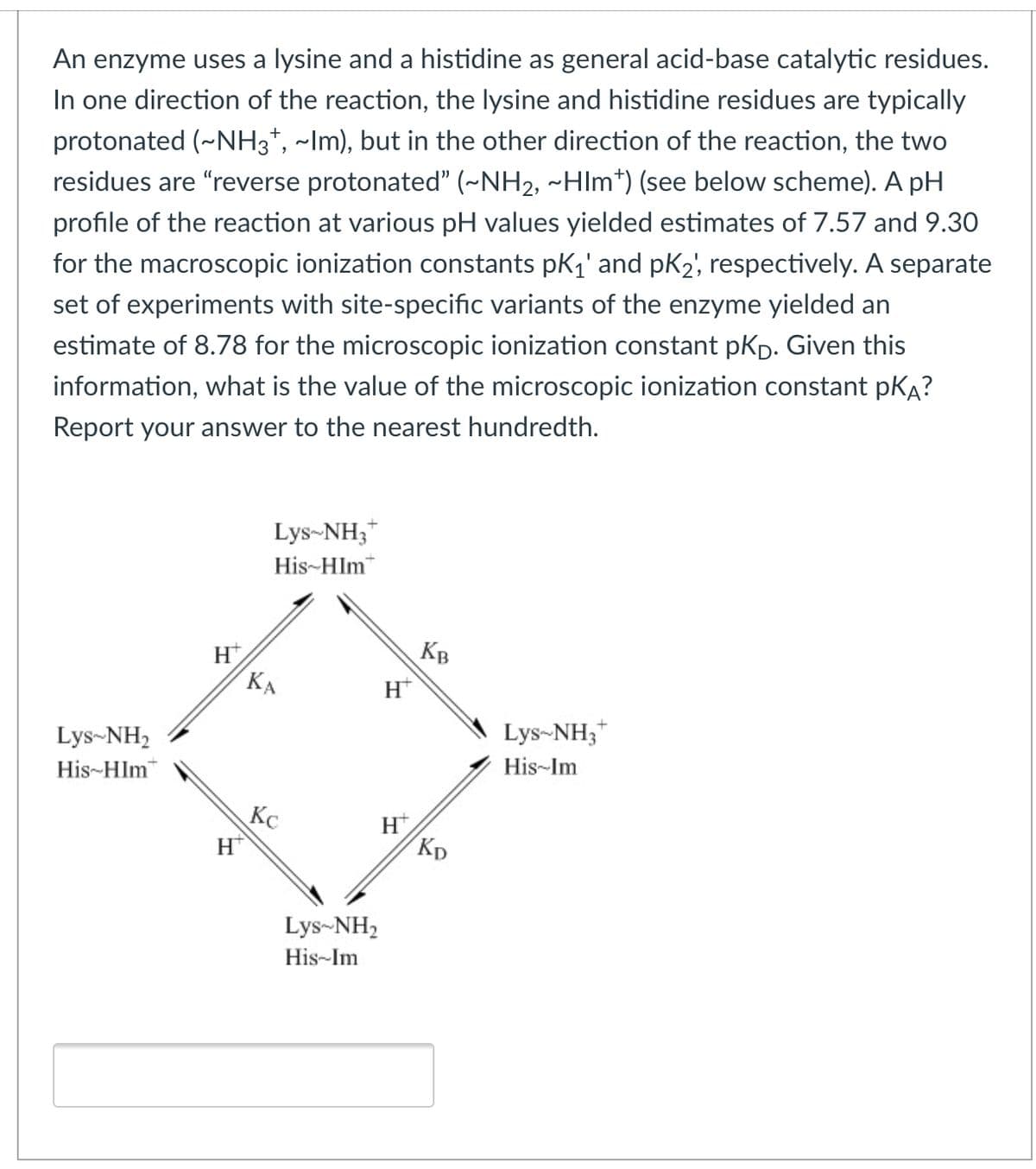estimate of 8.78 for the microscopic ionization constant pKp. Given this information, what is the value of the microscopic ionization constant pKA? Report your answer to the nearest hundredth.
estimate of 8.78 for the microscopic ionization constant pKp. Given this information, what is the value of the microscopic ionization constant pKA? Report your answer to the nearest hundredth.
Biochemistry
9th Edition
ISBN:9781319114671
Author:Lubert Stryer, Jeremy M. Berg, John L. Tymoczko, Gregory J. Gatto Jr.
Publisher:Lubert Stryer, Jeremy M. Berg, John L. Tymoczko, Gregory J. Gatto Jr.
Chapter1: Biochemistry: An Evolving Science
Section: Chapter Questions
Problem 1P
Related questions
Question
100%

Transcribed Image Text:An enzyme uses a lysine and a histidine as general acid-base catalytic residues.
In one direction of the reaction, the lysine and histidine residues are typically
protonated (~NH3*, ~Im), but in the other direction of the reaction, the two
residues are "reverse protonated" (~NH2, ~Hlm*) (see below scheme). A pH
profile of the reaction at various pH values yielded estimates of 7.57 and 9.30
for the macroscopic ionization constants pk,' and pK2, respectively. A separate
set of experiments with site-speciffic variants of the enzyme yielded an
estimate of 8.78 for the microscopic ionization constant pKp. Given this
information, what is the value of the microscopic ionization constant pKA?
Report your answer to the nearest hundredth.
Lys-NH3*
His-HIm"
KB
H
KA
H*
Lys-NH2
Lys-NH3*
His-HIm"
His-Im
Kc
H*
Kp
Lys-NH2
His-Im
Expert Solution
Step 1
Given,
pK1 = 7.57
pK2 = 9.30
pKD = 8.78
Trending now
This is a popular solution!
Step by step
Solved in 2 steps

Knowledge Booster
Learn more about
Need a deep-dive on the concept behind this application? Look no further. Learn more about this topic, biochemistry and related others by exploring similar questions and additional content below.Recommended textbooks for you

Biochemistry
Biochemistry
ISBN:
9781319114671
Author:
Lubert Stryer, Jeremy M. Berg, John L. Tymoczko, Gregory J. Gatto Jr.
Publisher:
W. H. Freeman

Lehninger Principles of Biochemistry
Biochemistry
ISBN:
9781464126116
Author:
David L. Nelson, Michael M. Cox
Publisher:
W. H. Freeman

Fundamentals of Biochemistry: Life at the Molecul…
Biochemistry
ISBN:
9781118918401
Author:
Donald Voet, Judith G. Voet, Charlotte W. Pratt
Publisher:
WILEY

Biochemistry
Biochemistry
ISBN:
9781319114671
Author:
Lubert Stryer, Jeremy M. Berg, John L. Tymoczko, Gregory J. Gatto Jr.
Publisher:
W. H. Freeman

Lehninger Principles of Biochemistry
Biochemistry
ISBN:
9781464126116
Author:
David L. Nelson, Michael M. Cox
Publisher:
W. H. Freeman

Fundamentals of Biochemistry: Life at the Molecul…
Biochemistry
ISBN:
9781118918401
Author:
Donald Voet, Judith G. Voet, Charlotte W. Pratt
Publisher:
WILEY

Biochemistry
Biochemistry
ISBN:
9781305961135
Author:
Mary K. Campbell, Shawn O. Farrell, Owen M. McDougal
Publisher:
Cengage Learning

Biochemistry
Biochemistry
ISBN:
9781305577206
Author:
Reginald H. Garrett, Charles M. Grisham
Publisher:
Cengage Learning

Fundamentals of General, Organic, and Biological …
Biochemistry
ISBN:
9780134015187
Author:
John E. McMurry, David S. Ballantine, Carl A. Hoeger, Virginia E. Peterson
Publisher:
PEARSON